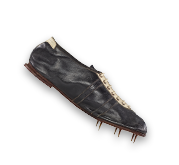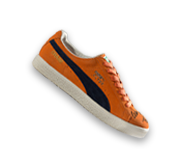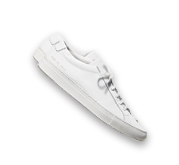











More than 150 rare and iconic sneakers are now in Perth.
After popular showings in Toronto, Brooklyn and Atlanta, the international exhibition The Rise of Sneaker Culture is on display at AGWA for its only Australian presentation.
The Rise of Sneaker Culture is the first exhibition to explore the complex social history and cultural significance of the footwear now worn by billions of people throughout the world.
On display are shoes from the archives of Adidas, Converse, Nike and Puma, as well as private collectors such as legendary hip-hop group Run-DMC, sneaker guru Bobbito Garcia (Kool Bob Love) and Dee Wells of Obsessive Sneaker Disorder. Also featured are sneaker collaborations between celebrities, artists and high-end fashion houses, including Kanye West, Damien Hirst, Prada, and Lanvin.
Among the shoes on display are an 1860s spiked running shoe, an original 1923 Converse All Star/Non Skid, a pair of 1936 track shoes, the original Air Force 1, and early Adidas Superstars. Also featured is a complete presentation of Air Jordans I–XX3 on loan from the Kosow Sneaker Museum.
Film footage, interactive media, photographic images, and design drawings contextualise the sneakers and explore the social history, technical innovations, fashion trends, and marketing campaigns that have shaped sneaker culture over the past two centuries.
GURU GUIDED TOURS | FREE
2pm, Wednesday – Sunday
Just for kicks, join one of our fab Guru Guides for a short introduction to the world of sneakers.
Or get a group together and book a free guided tour! Teachers can book guided tours and art workshops for primary, secondary, tertiary and access education groups. To discuss the free and paid tour options please contact education@artgallery.wa.gov.au
WA COLLECTORS
Alongside The Rise of Sneaker Culture, we're proudly presenting WA sneaker collector displays that pay homage to the passion, knowledge and pride of West-side sneakerheads.
Learn more about the WA Collectors
#MYSNEAKERSTORY
Got a sneaker story to share? We want to hear it! To celebrate the opening of The Rise of Sneaker Culture we’re giving you the chance to win a trip for two to San Francisco, thanks to Singapore Airlines, simply by sharing your favourite sneaker story via Instagram.













Converse Rubber Shoe Company All Star/Non Skid 1923. Converse Archives. Courtesy American Federation of Arts.
The Converse Rubber Shoe Company introduced its new indoor gym shoe, the All Star, in 1917. Brown canvas models were marketed as All Stars, while the same shoes in white canvas and with a slightly different tread were called Non Skids. Both featured the brand’s signature toe cap, toe bumper, license plate on the heel, and a patch over the inner ankle for protection. Basketball coach Chuck Taylor joined the company in the early 1920s, both to promote the sneaker and to advise on its design and development; his name was added to the All Star in 1934.
Dominion Rubber Company Fleet Foot ca. 1925. Collection of the Bata Shoe Museum. Photo: Hal Roth. Courtesy American Federation of Arts/Bata Shoe Museum.
Although women had been encouraged to participate in physical culture since the second half of the 19th century, it was not until the 1920s that women were able to embrace a wide range of sports and female athletes were first celebrated. Despite this, there were still concerns that women’s participation in athletics would detract from their femininity. This pair of rubber-soled footwear betrays these fears. The menswear influence seen in the broguing suggests that women were stepping into the masculine realm, but the high heels confirm that the wearer was, without question, feminine.
Gebrüder Dassler Schuhfabrik Modell Waitzer 1936. adidas AG. Photo: adidas AG / studio waldeck. Courtesy American Federation of Arts.
Adolf Hitler viewed the 1936 Berlin Olympics as an opportunity to flaunt his assertion of Aryan racial superiority through the athletic prowess of the German athletes. Jesse Owens, an African American competing for the United States, however, challenged these views, winning four gold medals and becoming the winningest American Olympian to that date. German shoemaker and future Adidas founder Adi Dassler boldly offered his athletic shoes to Owens, who tested them while at the Olympics. The type of shoe Owens wore was a bespoke pair of Modell Waitzers, named after the German national coach Josef Waitzer, similar to this shoe.
Nike Waffle Trainer 1974. Northampton Museums and Art Gallery. Photo: Ron Wood. Courtesy American Federation of Arts/Bata Shoe Museum.
In his quest to make lightweight running shoes, Bill Bowerman was constantly seeking improvements. In 1965, he collaborated with Blue Ribbon Sports’s first employee, Jeff Johnson, to introduce nylon uppers and cushioned insoles, but it was not until he destroyed his wife’s waffle iron by pouring rubber into it that he revolutionized the running shoe. Bowerman’s experiment inspired him to create soles that used less material, yet featured durable treads. His famously lightweight Waffle Trainer debuted in 1974.
adidas x Run–DMC 25th Anniversary Superstar 2011. Courtesy of Run–DMC, collection of Erik Blam. Photo: Ron Wood. Courtesy American Federation of Arts/Bata Shoe Museum.
In 1986, a second pivotal moment occurred in sneaker culture history: Run–DMC invited Adidas executives to Madison Square Garden to hear them perform their hit single “My Adidas.” Adidas responded by giving the rappers a million-dollar contract, making them the first non-athletes to receive a sneaker deal. Run–DMC wore Superstars without laces, a controversial choice as the fashion originated in prisons, where laces were removed as a safety precaution. This pair of Adidas Superstars was released on November 11, 2011 in honor of the rap single’s 25th anniversary and was autographed by Rev Run and DMC for this exhibition.
Nike x Supreme Dunk High Pro SB 2003. Collection of Andrew Liem. Photo: Ron Wood. Courtesy American Federation of Arts/Bata Shoe Museum.
Nike ventured into the world of skateboarding in 2002. The Supreme Dunk High Pro SBs were highly anticipated and released only in New York and Tokyo. Hallmarks of the design are the gold stars and mock-croc leather of the uppers and the gold ornament, called a debray, on the laces. Only one thousand Supremes were released in the White/University Blue colorway, making this one of the most sought-after sneakers of all time.
Pierre Hardy Poworama 2011. Collection of the Bata Shoe Museum, gift of Pierre Hardy. Photo: Ron Wood. Courtesy American Federation of Arts/Bata Shoe Museum.
Pierre Hardy launched his line of footwear for men in 2002. Among his many designs are sneakers that play with primary colors and geometric shapes. The design of this pair of limited edition Poworamas was inspired by the artwork of Roy Lichtenstein and translates the artist’s graphic appeal into wearable art.
Common Projects Achilles Low 2015. Common Projects Archives. Courtesy American Federation of Arts.
Common Projects’s clean, minimalist aesthetic and low-batch, high-quality manufacture, coupled with its cryptic numbering system stamped in gold on the back quarters of their shoes, has propelled the brand to cult status. Common Projects reflects the fashion aesthetic labeled “Normcore,” a trend identified in 2014 indicating a shift toward unassuming, understated styling that rejects ostentatious branding. The Achilles, a stripped-down yet luxurious version of an iconic low-top, was the first model designed by company co-founders Peter Poopat and Flavio Girolami when they launched Common Projects in the mid-2000s.
Nike x Tom Sachs Whites (Original) 2008-12. Collection of the artist. Courtesy American Federation of Arts.
Artist Tom Sachs rose to fame creating works that engage issues around the fetishization of branding. He is a proponent of the concept of bricolage, working with materials at hand, and his work highlights the maker’s mark in response to the perfected anonymity of mass-produced consumer goods. Sachs began working on NikeCraft, his collaboration with Nike, with these principles at the forefront. This moon boot was a prototype for the collection.
Lanvin Patent Cap Toe 2013. Collection of the Bata Shoe Museum, Gift of Holt Renfrew. Courtesy American Federation of Arts/Bata Shoe Museum.
Lanvin, the oldest couture house in Paris, has been making exquisite haute couture clothing for women for more than one hundred years. In 2005, the house branched out into menswear and began offering sneakers. This sleek, understated Lanvin patent toe-cap sneaker is now a legend among fashion-forward men
Nike Stewie Griffin Lebron VI 2009. Collection of Chad Jones. Courtesy American Federation of Arts/Bata Shoe Museum.
Basketball player LeBron James is a style icon on and off the court. The bold graphics, color palette, and cartoon-like quality of this pair of exceptionally rare sneakers were inspired by Stewie Griffin, LeBron’s favorite character from the animated television show Family Guy. The shoe was never put into production and just twenty- four pairs were made, available to friends and family by invitation only.
adidas Stan Smith ca. 1980s. adidas AG. Photo: adidas AG / studio waldeck. Courtesy American Federation of Arts.
The Stan Smith is one of Adidas’s most popular styles. Its first iteration was created for French tennis great Robert Haillet in 1964. In keeping with the all-white rule for tennis clothes, embellishment was limited to Haillet’s signature and a small green felt tab at the heel. Adidas’s classic three stripes were rendered in perforated holes to increase circulation.

As part of the SNEAKERHEADS season and accompanying the exhibition The Rise of Sneaker Culture is a range of programs aimed at showcasing and celebrating the buoyant sneaker culture of Western Australia.
Explore the connections with design, sport, fashion and music through collaborations with Curtin University and Fashion Council WA on designing the WA Sneaker; the Department of Sport and Recreation on My Sneaker Story; WA Music on sneaker sounds; and the second AGWA Art Ball.
10am-5pm, 13 May – 4 September 2017
Celebrated sneaker retailer, Highs and Lows, has set up shop at AGWA in an exciting retail collaboration. Check out their pop-up store for the latest kicks and limited edition merchandise.




This is a thought-provoking and informative exhibition…
Walking through the exhibition, it becomes quickly apparent just how much these shoes are genuine works of art. It’s quite dazzling, and surprising, and magical.
Organised by Major Partner for presentation at AGWA

The Rise of Sneaker Culture is organised by the American Federation of Arts and the Bata Shoe Museum. The exhibition is curated by Elizabeth Semmelhack, Senior Curator of the Bata Shoe Museum.
Coordinating Curator, Robert Cook, AGWA Curator of Contemporary Design and International Art.
Sneakerheads Partners

Media Partners

GALLERY OPEN
Wed to Mon 10am-5pm
Closed Tuesdays, Good Friday and Christmas Day
Entry is free, donations welcomed. Special exhibitions may incur a ticket fee.
